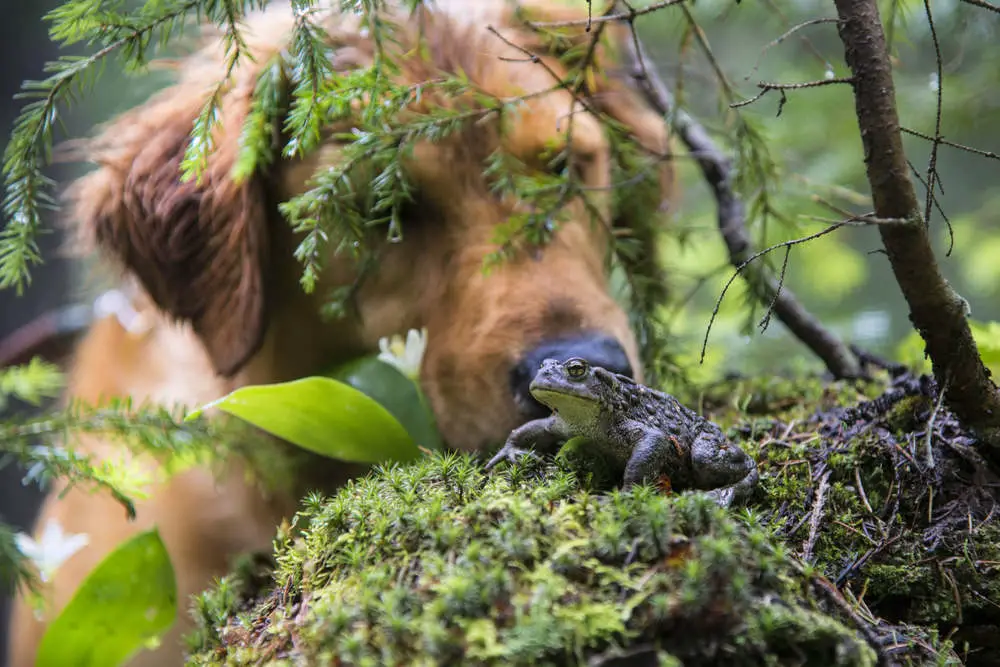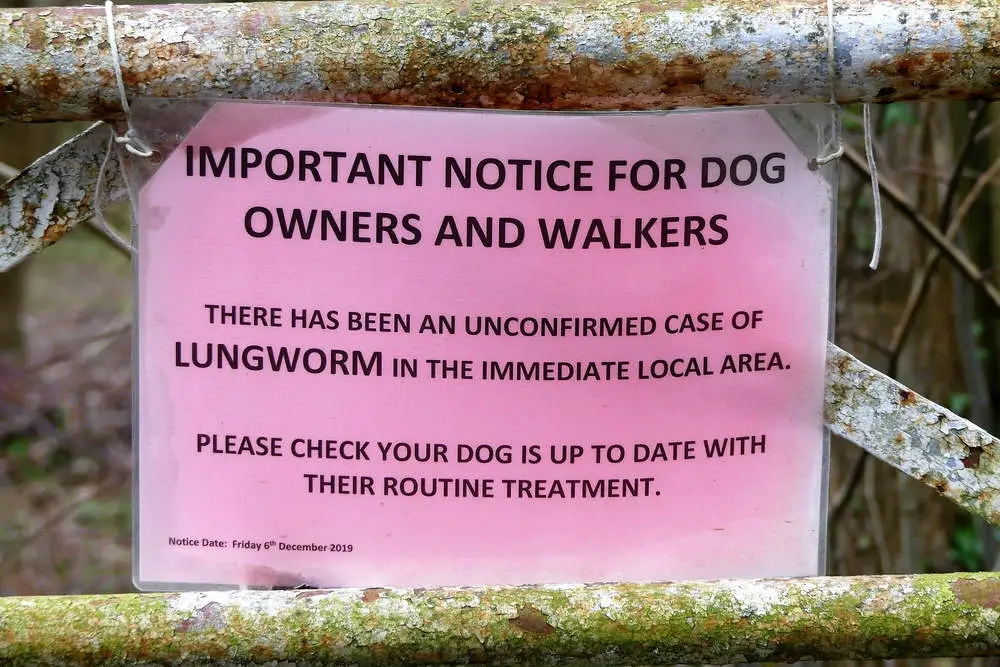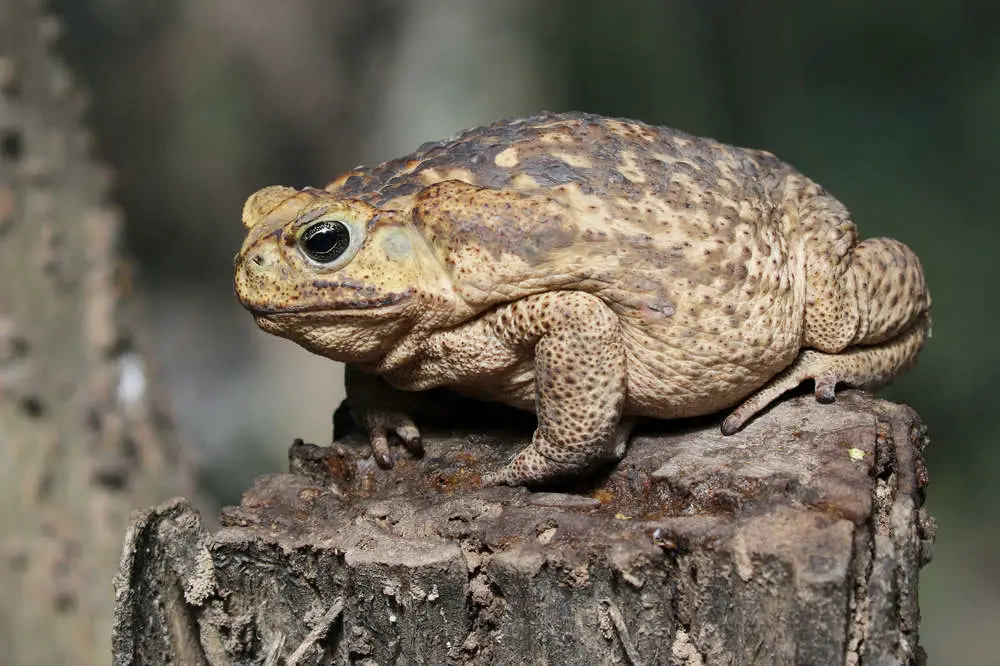
Dogs, sometimes, make questionable food choices. On their many adventures out in the wild, they come across certain small creatures that fascinate them. Sometimes, their curiosity gets the better of them, and they give into their predator mindset.
Have you ever wondered what happens if your dog ever decides to eat a frog?
There is some cause for concern when it comes to frogs and toads. In this article, let’s delve deep into the world of dogs eating frogs and what to do when such an unfortunate incident happens.
Why Does My Dog Eat Frogs?
Have you ever stared at your furry little friend and wondered what drives them to chase after small critters like frogs?
Dogs are close familial matches to wolves. The survival instinct of wolves involves following their prey drive to hunt and eat smaller animals. Some semblance of this drive is present in your domesticated dogs too.
The instant dogs spot smaller animals like mice, frogs, and toads, their innate prey drive gets triggered, and they are off chasing down the smaller creature.
Unfortunately, this innate drive does not help them distinguish between what is good and what is bad for them.
They may think of frogs as simply a treat to be enjoyed. Another reason they may go after them might be for play. They may view the jumping frogs as a toy to be played with and chase after them.
While they might not intend to eat the frog, they could end up chomping down if surprised.
But what happens if a dog bites down or eats a frog?
How Safe Are Frogs for My Dog?
To answer this question, you need to answer this one—where do you live?
Whether a frog is safe or not largely depends on the type of frog your dog ingested. The types of frogs vary from place to place. For instance, if you live in a rainforest, you are likely to be surrounded by poisonous frogs. This spells trouble for your dog.
Additionally, you may not even have frogs in your region. It could be worse, and your dog might be holding a toad in its mouth. While there are many species of these small creatures in different regions of the world, not all are toxic.
The major issue with dogs eating frogs or toads is the risk of poisoning. Certain species are highly toxic. They are loaded with a defense mechanism that is lethal to small animals and sickening to larger ones.
This defensive toxin is secreted when the tiny creature feels cornered or alarmed. The glands push the toxin out and onto the skin. These toxins have an anesthetic-like effect, affecting nerve conduction in addition to heart rate.
If your dog ingested a toxic frog or a toad, they are likely to exhibit certain symptoms following the counter. These symptoms depend on your dog’s size and health, the species of frog or toad, and when the incident happened.
Also Read: My Dog Ate Play-Doh, What Should I Do?
What Can Happen If My Dog Ate a Frog?

Besides poisoning, ingesting a frog could result in your dog developing a lungworm infection. This infection is caused by parasitic worms nesting in the frog. If infected, it can cause a wide range of serious health problems in your dog.
Fortunately, this diagnosis is a rare one. Despite it being uncommon, it is important to be aware of what can happen in case of a lungworm infection due to eating frogs.
Certain dogs, such as puppies and spaniels, are more prone to getting a lungworm infection compared to others. The reason behind the higher risk of contraction is not yet clear. It is likely due to a defective gene in the breed.
These are some of the possible indications of lungworm infection. Keep an eye out for signs of:
- Breathing problems
- Diarrhea
- Vomiting
- Behavioral changes
- Anemia
- Coughing (with blood)
- Nose bleeds
- Lack of appetite
- Weight loss
- Easily exhausted
- Red eyes
However, since these symptoms match with other illnesses too, it can be quite easy to misinterpret them. If you suspect that your dog ate a toad or a frog followed by these symptoms, get them to a vet for proper treatment.
The infection is easily treatable with medicines, provided it is diagnosed at an early stage.
Since the lungworm infection can spread through feces, make sure you clean up properly.
Besides carrying parasitic worms, toads and frogs are also potential carriers of salmonella. If your dog munches on a critter carrying salmonella, they can suffer from severe gastric problems.
Symptoms to Indicate My Dog Just Ate a Frog
Sometimes, even a lick is enough to affect the health of your dog. In most cases involving a non-toxic frog, your dog is likely to suffer minor irritation in the oral cavity for a while.
You will notice your dog paw the mouth or drink a lot of water to wash away the unpleasant taste.
However, if your dog came in contact with a toxic toad or a frog, you will notice the symptoms almost immediately. The reaction will be highly irritating and your dog will show obvious signs of discomfort.
In addition to pawing the mouth, your dog might froth at the mouth, vomit, whimper, and shake their head.
Other symptoms that could indicate your dog ingested a toad or a frog include:
- Excessive drooling
- Reddened gums
- Difficulty breathing
- Difficulty walking
- Vomiting
- Diarrhea
- Irregular heart rate
- Dilated pupils
- Convulsions
Luckily, in most cases, the symptoms experienced are often mild. But they can last over a few hours.
In severe cases, the symptoms can progress from mild to severe rather quickly. You will notice tremors and twitchy eyes. Your dog will likely have trouble moving normally.
Treatment must be administered at the earliest. Without treatment, the poisoning will spread further and slow down the heart rate. This could eventually lead to death.
Also Read: 7 Home Remedies to Treat Your Dog’s Upset Stomach
What to Do If My Dog Ate a Frog?
If your dog ate a common frog, you have no cause for worry. However, if it was a toxic species, you must seek medical help immediately. If you are unsure what kind of frog or toad your furry friend ingested, seek help nevertheless.
Before you speed off to the vet, there are a few things you can do to help your dog. First things first—remain calm.
If the frog is still in your dog’s mouth, remove it gently. Do this calmly. You do not want to fight your dog and create another issue altogether.
Next, you have to clean their mouth. Get a damp cloth, and clean your dog’s mouth thoroughly. Wipe away any remnants of the meal from the teeth and gums. Do this for 10 minutes. This thorough clean-up process will get rid of any remaining toxins.
You can also rinse out your dog’s mouth with some water. However, you have to be extremely careful. You do not want to squirt water straight into your dog’s throat. This can spread the toxins further down or accidentally choke them.
Once you have cleaned up your pooch, get an emergency appointment and head over to the vet’s office. If possible, get a sample of the culprit for your vet to run tests on. This will help your vet decide on the course of treatment.
How to Prevent Your Dog from Eating Frogs
There is very little you can do to prevent your dog from chomping down on the little critters, especially if you live in a region where the toads and frogs thrive.
However, you can train them to a certain level to avoid frogs. Under the guidance of obedience commands and your vigilant eyes, they can avoid coming in contact with toads or frogs altogether.
This can be slightly tricky if you are living in a region overrun by toads and frogs. However, it takes some maneuvering and tricks to get it right.
The first thing you should do is familiarize yourself with the frogs’ routines. These tiny creatures are primarily nocturnal. This means they get active once the sun sets. This is when you should keep an eye on your four-legged furry friend.
Do not let your dog out without supervision during nocturnal hours. Avoid night walks or playtimes, even in the backyard. If you must let them out at night, keep a stern eye on them so that there is no accidental ingestion.
Make sure your dog has a great grasp on following commands. If, for instance, during one of your walks, curiosity gets the better of your dog, and they rush off to catch a frog, a firm ‘no’ or ‘drop it’ should be enough for your dog to follow through and save the pooch from some serious discomfort.
Frogs can also leave toxins in the water. Therefore, do not leave water bowls outside. Get the bowls inside before sunset and wash them well.
Also, keep the grass in your yard trimmed short to reduce the chance of frogs or toads hopping into your space for cover.
How to Identify Poisonous Frogs

A lot of toads and frogs in North America are not highly toxic to dogs. However, there are certain species you need to look out for. A toxic frog is usually noticeable based on its color. If it is brightly colored, it is likely to be toxic.
Toads, on the other hand, are harder to spot. But there are two common types of toads that you should know how to recognize and avoid.
One is the giant toad or the cane toad. You will see it commonly across Texas, Florida, and other tropical regions. The other is the Colorado River toad.
Also Read: Can Dogs See Phone Screens?
The Bottom Line
It can be quite difficult to keep an extremely close eye on your pooch all the time. It is likely they will get away from you and give in to their curiosity to taste or eat something they should not.
This is not always a cause for worry, but vigilance ensures the safety of your pet and keeps them from experiencing unpleasant consequences.
If your dog is exhibiting the above-mentioned symptoms or you are unsure what to do, get in touch with a medical professional at the earliest to prevent the problem from turning into a serious matter.
